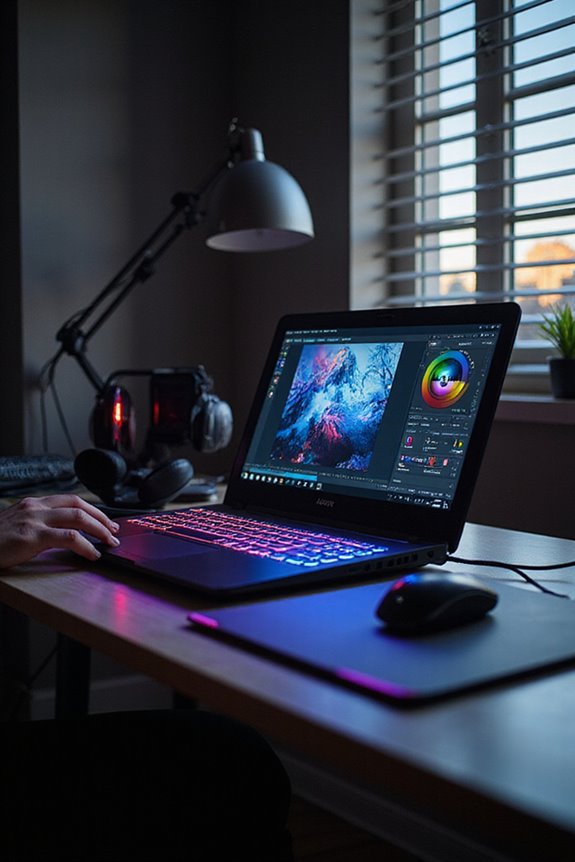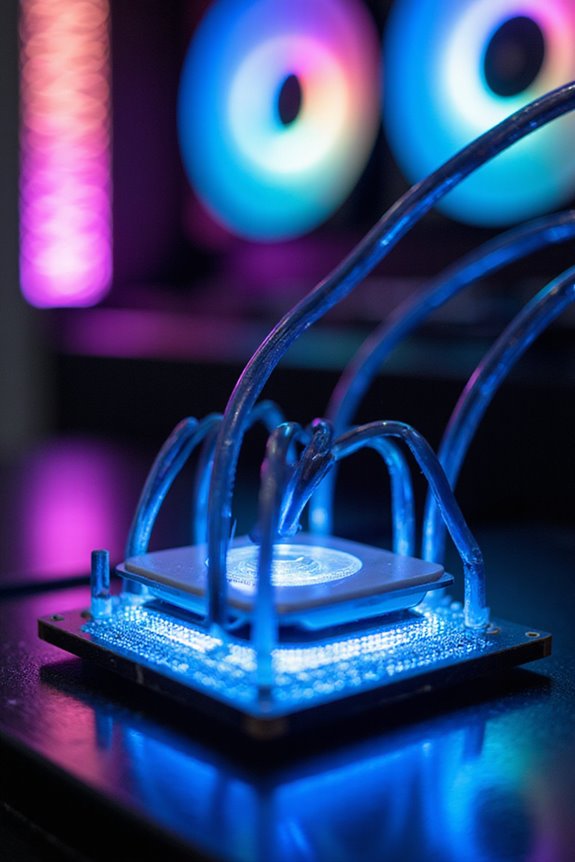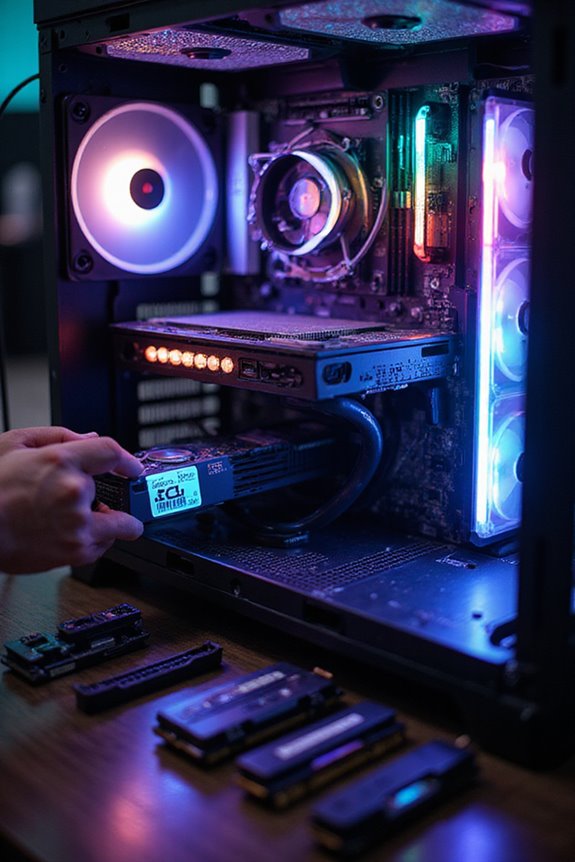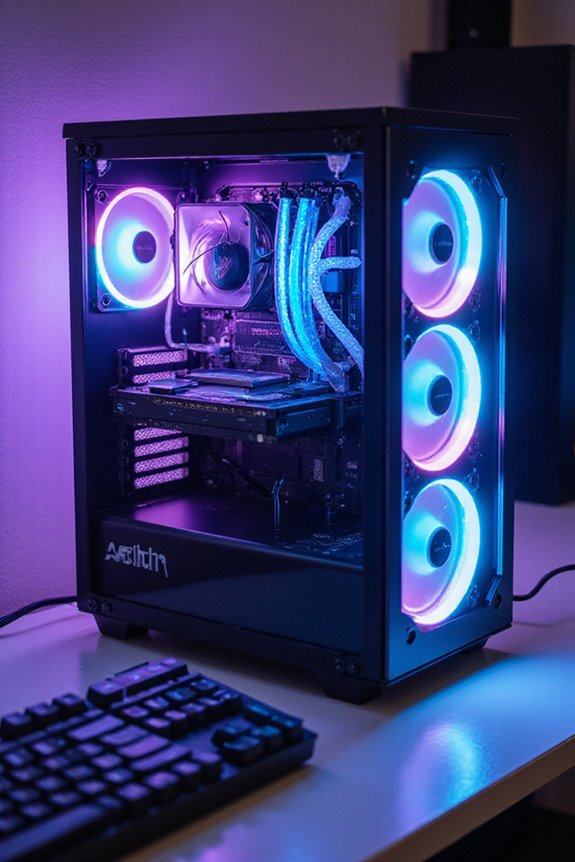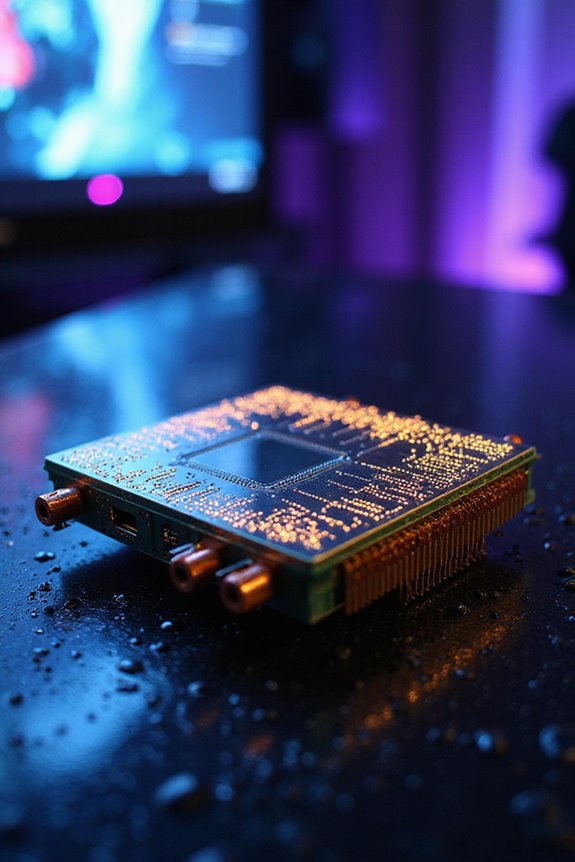Gaming laptops are transforming into creative powerhouses thanks to their potent CPUs and GPUs. I’m talking about impressive specs like Intel’s Core i9-14900HX or AMD’s Ryzen 9, which tackle multitasking like pros. With NVIDIA’s RTX series, workflows speed up, especially for rendering and color grading. Plus, vibrant OLED displays enhance visuals greatly. While the heavy design can be a downside, the performance benefits are hard to beat. Stick around, and I’ll share what to look for in your next creative setup.
Key Takeaways
- Upgrade RAM and SSD for improved multitasking and faster load times, enhancing overall workflow efficiency for creative tasks.
- Utilize advanced GPUs like NVIDIA’s RTX series to accelerate rendering and streamline effects in creative software.
- Leverage high-end processors, such as Intel Core i9 or AMD Ryzen 9, for superior performance in demanding applications.
- Invest in high-quality displays, including OLED or mini-LED, for accurate colors and details in creative projects.
- Implement dual-screen setups for enhanced multitasking, allowing simultaneous management of multiple creative applications.
The Rise of Gaming Laptops in Creative Fields
As gaming laptops become more prevalent in creative fields, it’s fascinating to see how they’ve evolved to meet the needs of both gamers and creators alike. With the market projected to hit $24.86 billion by 2029, it’s clear there’s a rising demand for these powerful machines. I’ve noticed many content creators, from digital artists to video editors, embracing gaming laptops for their high specifications. Models like the Razer Blade 18 and MSI Titan shine with advanced cooling and customizable hardware. Sure, they can be heavy, but their performance in creative software is hard to beat. Plus, the dual-screen trend is a game-changer, enhancing multitasking for those of us juggling projects. It’s an exciting time, indeed!
Harnessing Powerful Processors for Creative Tasks
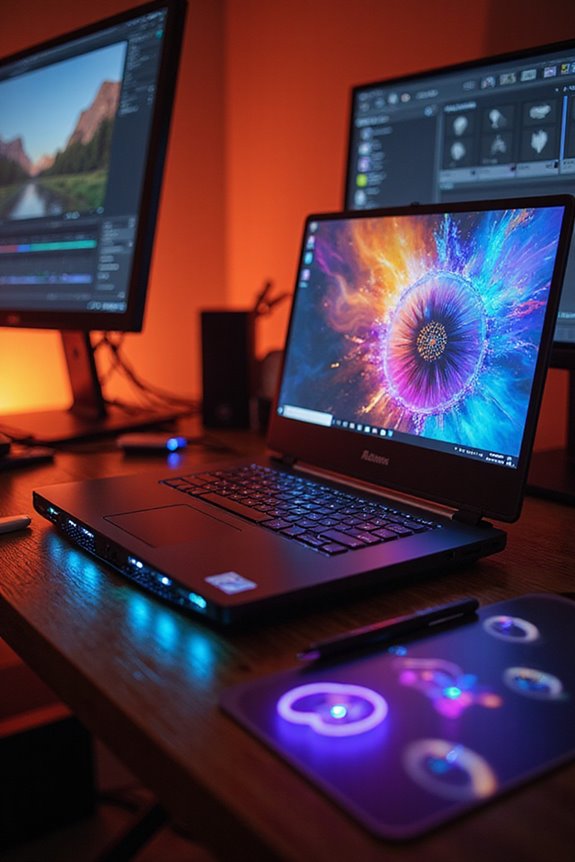
When diving into creative tasks, the power of a robust processor can’t be overstated. High-end CPUs, like the Intel Core i9-14900HX or AMD Ryzen 9, boast multiple cores that excel at multitasking—perfect for video editing or 3D rendering. I’ve noticed significant speed improvements when working with demanding software, thanks to their advanced architectures, which deliver impressive benchmarks. With efficient thermal management, these processors maintain peak performance during long sessions, avoiding that dreaded throttling. Plus, their power efficiency extends battery life, allowing me to work longer without needing a charge. It’s clear that these processors are not just for gaming; they’re transforming laptops into true creative powerhouses that fuel my passion for content creation.
The Impact of Advanced Graphics Cards on Content Creation
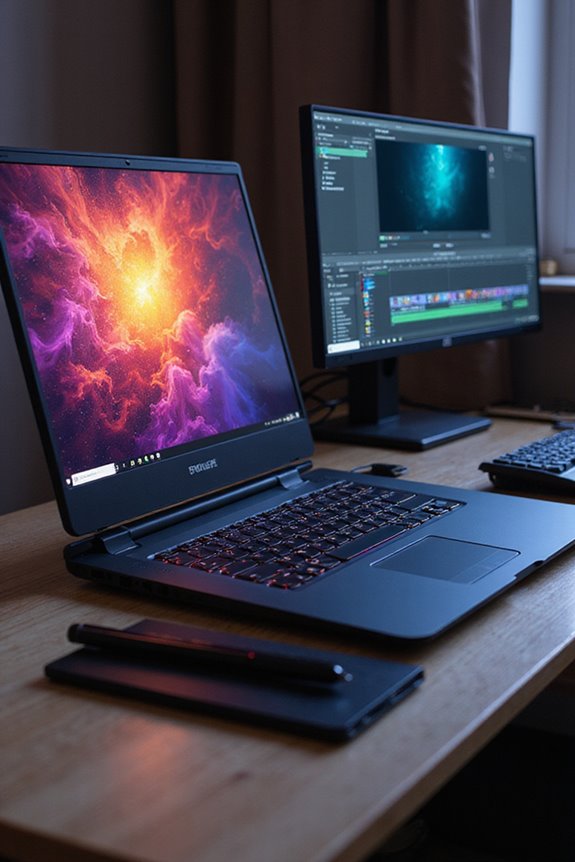
Advanced graphics cards play a pivotal role in content creation, especially when it comes to enhancing rendering and real-time performance. With powerful GPUs, like NVIDIA’s RTX series or high-end AMD models, I can speed up rendering in programs such as Adobe Premiere Pro, drastically cutting down export times. Those GPU-accelerated effects? They make high-quality changes and color grading feel effortless.
Moreover, features like intelligent frame interpolation guarantee my videos run smoothly, essential for high-frame-rate projects. Real-time ray tracing brings a touch of realism with stunning lighting and shadows, elevating my 3D work. Sure, these GPUs can be pricey, but the efficiency and quality they bring to my projects are undeniably worth it, making my creative process more enjoyable.
Maximizing RAM and Storage for Efficient Workflows
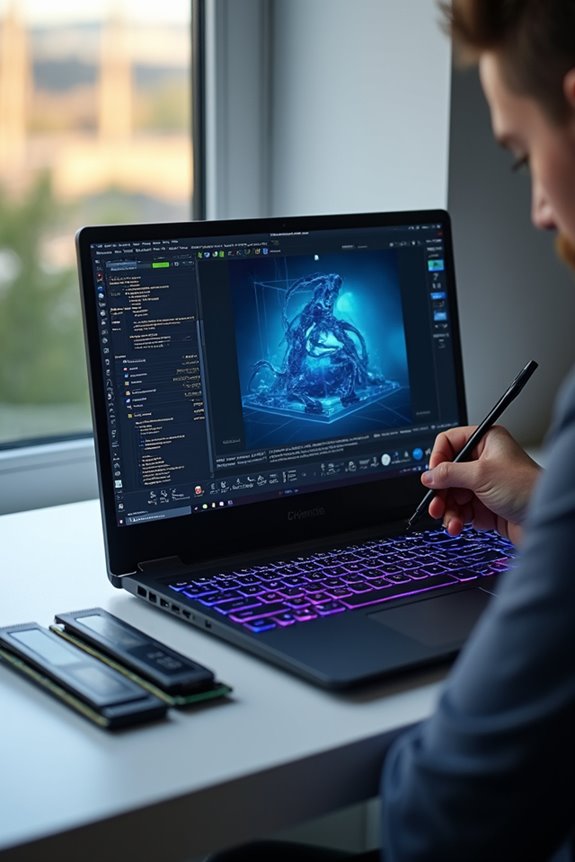
Maximizing RAM and storage is essential for anyone looking to streamline their creative workflows. I’ve found that increasing RAM capacity allows me to juggle multiple applications effortlessly, whether I’m editing video or designing graphics. Faster RAM speeds can boost my system’s responsiveness, making everything feel snappier.
When it comes to storage, opting for SSDs over traditional HDDs has made a noticeable difference in load times. And hey, if I need more space, external drives and cloud storage help keep my projects organized and accessible. Remember, upgrading doesn’t have to break the bank; it’s often more cost-effective than buying a new laptop. Just verify compatibility with your system, and you’re good to go!
Enhancing Visual Experiences With High-Quality Displays
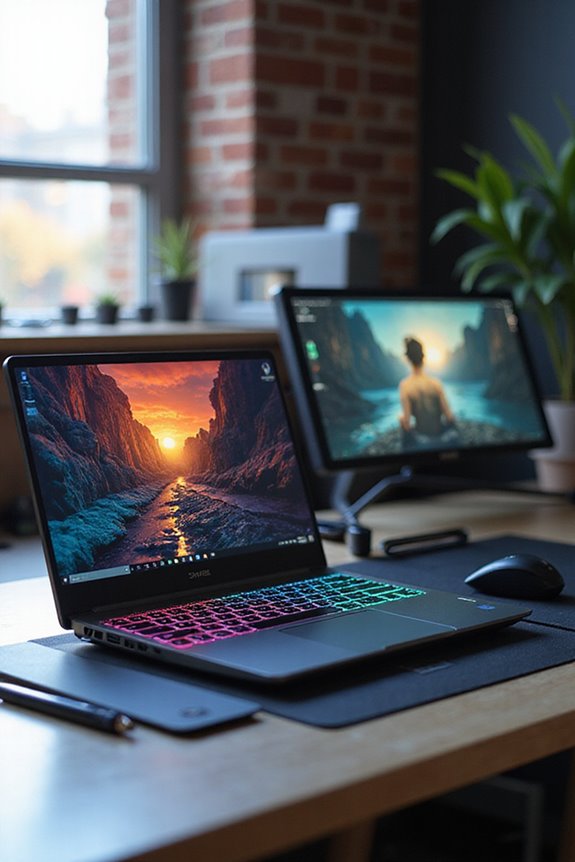
While many overlook the importance of display quality, I’ve found that it can dramatically enhance my creative experiences. Choosing the right screen, like an OLED or mini-LED, brings true blacks and vibrant colors to life, making my artwork pop. With resolutions like QHD or UHD, I can see every detail, ensuring my work is precise and visually stunning. High refresh rates, especially for dynamic content, reduce motion blur, allowing for a smoother experience when editing videos or gaming. However, I’ve learned to balance these features with system performance—higher resolutions can be demanding. For those involved in video editing tasks, HDR monitors can greatly enhance color accuracy and contrast, providing a more immersive and precise editing environment. Ultimately, a high-quality display isn’t just a luxury; it’s an essential tool that transforms how I create and interact with my work.
Optimizing Cooling Systems for Prolonged Creative Sessions
To keep your laptop running smoothly during those long creative sessions, enhancing the cooling system is vital. I’ve found that adjusting fan speeds can really help balance noise and cooling efficiency. It’s great to create custom fan curves, targeting specific usage scenarios for peak performance.
Using a cooling stand elevates your laptop, improving airflow and preventing overheating. Plus, I prefer surfaces that allow for better air circulation—they make a real difference. And don’t forget about regular maintenance; keeping those vents clean is significant for effective cooling.
If you manage workloads smartly—like capping frame rates—you’ll notice less heat without sacrificing performance. It’s all about finding that sweet spot for stability while you immerse yourself in your creative projects.
Integrating AI and Animation in Creative Projects
As I plunge into the world of animation, I can’t help but appreciate how integrating AI has transformed the creative landscape. With AI automation, tasks like keyframing and rotoscoping become less of a chore, letting me focus on my vision. Generative tools like Adobe Firefly simplify creating backgrounds and characters, while Runway ML offers real-time results that make the process feel almost magical.
AI-driven motion capture, like DeepMotion, allows me to animate characters from video footage effortlessly. However, while these tools greatly enhance productivity and creativity, I sometimes find myself missing the hands-on feel of traditional animation. Still, the efficiency and accessibility AI brings are undeniable. It feels like having a creative partner, ready to help whenever inspiration strikes.
The Future of Gaming Laptops in the Creative Industry
Gaming laptops are not just for high-octane gaming anymore; they’re carving out a significant place in the creative industry, too. With advancements in processors and graphics cards, these machines excel at video editing and graphic design. Their lightweight design allows me to take my work anywhere, which is a game-changer for on-the-go projects.
As the market grows, expected to hit $17.64 billion in 2025, the cost-effectiveness of gaming laptops stands out. They offer comparable performance to traditional workstations without breaking the bank. Sure, they face challenges keeping up with evolving software demands, but the integration of AI and innovative cooling systems makes them more appealing. I can’t wait to see what the future holds for these creative powerhouses!
Frequently Asked Questions
Can Gaming Laptops Handle 4K Video Editing Effectively?
Absolutely, I’ve found that gaming laptops can handle 4K video editing quite well. Their powerful processors and GPUs really shine, making the editing process smoother and more enjoyable than I ever expected.
What Software Is Best Optimized for Gaming Laptops?
Oh, if only I could sing the praises of gaming laptops! Honestly, they’re perfect for Adobe Creative Cloud, Blender, and DaVinci Resolve—software that dances effortlessly, turning my creative dreams into reality. You won’t regret it!
Are Gaming Laptops Suitable for Graphic Design Work?
Absolutely, I’ve found gaming laptops perfect for graphic design. Their powerful processors and dedicated GPUs handle demanding tasks effortlessly. Plus, the vibrant displays bring my designs to life. It’s a game-changer for creativity!
How Do I Choose the Right Gaming Laptop for Content Creation?
When picking a gaming laptop for content creation, I always look for a powerful processor, a stunning graphics card, and ample RAM. It’s essential it feels right too—like a cozy home for my creativity.
What Are the Advantages of Using Gaming Laptops Over Traditional Laptops for Creative Tasks?
When I think about using gaming laptops for creative tasks, I find their powerful processors and vibrant displays make a huge difference. They handle demanding software effortlessly, giving me the flexibility I need for my projects.

